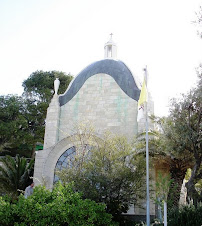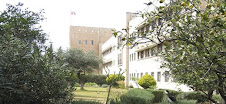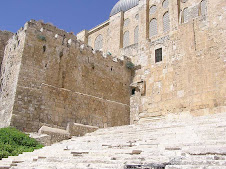First, thank you to George Carey and the Tantur Trust here and to Fr Michael McGarry and all the staff of the Tantur Institute, to Michael Roberts and Kathleen O'Gormon, for getting me somewhere that I had always resisted going to on a visit that exceeded all my expectations.

It was salutary to be prompted by Miroslav Volf to see things from ‘the other’s’ point of view. I saw through the eyes of Rabbi David Rosen, and Debbie Weissman, through the eyes of Hannah and our other wonderful Jewish guide. At Yad Vashem I could see that the State of Israel was the light at the end of the Holocaust’s tunnel. I found myself admiring the democratic institutions of the State of Israel, and I could understand the value of a Security Fence. And indeed I felt surprisingly secure.
I saw through the eyes of Palestinian Muslim Mohammed Hourani and of Palestinian Christian Alex Awaad. I went through the checkpoint on my own and met up with a friend from Cheltenham who that week had received the Passport to Bethlehem from the Open Bethlehem movement she took me to the roof top of Yusef’s home in Dheisheh refugee camp. Same age as me – living still on the spot his parents had been moved to in 1948, working in Bethlehem and years since he had been permitted into Jerusalem and Israel. I saw the view from the Shepherds’ fields of a new settlement and the fenced tarmaced road. I saw the You Tube videos since our return of the destruction by Israeli soldiers of the sewing workshop we visited in Hebron. I saw Israelis and Palestinians who simply had no opportunity to meet let alone talk with each other.

Worst of all the little 12 year old Palestinian girl in the taxi who had only ever met and played with an Israeli girl at a reconciliation conference in Japan And I despaired at the brutality of an apartheid wall.
I had the awful feeling and still do of impotence. What can I do? Support, come alongside and pray those who are there in the middle of the conflict. For the churches we visited and worshipped with who are committed to the task of reconciliation. People like Dr Petra Heldt, those involved in the Lutheran centre in Bethlehem, the reconciliation work of Wiam, The presence of the Christian Peace maker team in the middle of the tension of Hebron. The kids4peace initiative we heard of, the work of Tantur in bringing Israeli and Palestinian together.

In quite a different way and equally surprising that feeling of impotence gave way to inspiration for Tantur’s vision of ecumenism. Meeting with such a wonderful mixed group of people from so many different churches there was the opportunity to see through the eyes of the other in an ecumenical sense. From his experience of conflict in Croatia Miroslav Volf is certain
“We enlarge our thinking by letting the voices and perspectives of others, especially those with whom we may be in conflict, resonate within ourselves, by allowing them to help us see them, as well as ourselves, from their perspective, and if needed readjust our perspective as we take into account their perspectives”[1]
If we are to see through the eyes of the ‘other’, he suggests, we need to cultivate the art of ‘double vision’. “The practice of double vision presupposes that we stand within a given tradition and learn from other traditions.’
It was wonderful to begin the day present at Latin Mass, and then Anglicn Morning Prayers, wonderful visiting the Orthodox Church of the Annunciation in Nazareth and having Fr Ian, Greek Orthodox Priest in Oxford, explain the architectural theology of an Orthodox Church and standing in front of the Altar of the Carmelite Church of Pater Noster on the Mount of Olives as he described the mathematical theology of the Rublev Icon. But on Sunday I was delighted to worship in my tradition at the East Jerusalem Baptist Church in the morning and in a house church in Bethlehem in the evening, and at our last prayers in Tantur to find the chairs rearranged in good free church circular style!
The Bible came to life in a way I had been told would happen, but in a way that I had not believed possible. On those steps up to the Temple, when we saw the ugly brutality of Herod’s rule at the Herodion, and as Henry Carse related geography, geology, landscape, archaeology, and text in remarkable fashion in Galilee.

It was in the Capernaum Synagogue that things came together for me. That picture of the Synagogue on wheels excited Henry Carse. His simple tree intertwining Judaism and Christianity made sense of so much for me. As much as in the Temple and the Holy of Holies, the Rabbis maintained that in the synagogue, “when they sit together and are occupied with the Torah, the Shekinah is among them.” We sat in that Synagogue and engaged in the process of listening and asking questions of the Scripture, gathering around the Scripture and sensing the presence. And I found it for me at one and the same time a reaffirmation of my own roots in the Bible and a recognition of the rootedness in the Bible of all those I was on this journey of reconciliation with.

Lisa’s picture of three new friends says it all for me.
Fr Ian’s Orthodox wisdom and richness rooted in the temple worship so valued by Jesus and the first Christians in Jerusalem.
Matthew, my room mate, we really miss today, from a charismatic church rooted in the Corinth church with its gifts of the Spirit and speaking in tongues.
My own Congregational way of being the church with worship centred on preaching with the expectation in Pastor John Robinson’s words that there will always be more light and truth to break forth from God’s Word finds its roots in the synagogue and that process of listening to and asking questions of the Scriptures. Where two or three gather together, synagogue together, in my name there am I in the midst.
I came back with a renewed sense of the thrill of belonging where I belong in my tradition and of that kind of ecumenism that affirms the wonderful ‘hybridity’ there has always been in the church of Jesus Christ.
The silence on the boat in the Sea of Galilee for me really was ‘the silence of eternity interpreted by love.’ We had read Matthew 14. The brutality of the story of the beheading of John the Baptist I had witnessed in a way I had never done before in Jerusalem, Bethlehem and Hebron. But the love of Christ in his teaching, his healing and his feeding of the 5000 I had witnessed as well. And in the middle of the storm those wonderful words of Christ, we had shared before in prayers on the coach on the way home from Hebron.
Take heart. It is I. Be not afraid.
That sense of presence – in the boat on the Sea of Galilee after we had read Matthew 14. Three stories – the brutality of the beheading of John the Baptist by Herod Antipas whose Tiberias we were staying in, the teaching and love of Christ in the feeding of the 5000 and then the presence of Christ in the middle of the storm.
Those words of his … against the background of all that we had experienced in and around Jerusalem I will take with me …
Take heart. It is I. Be not afraid.

%2BChurch.jpg)






